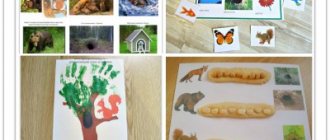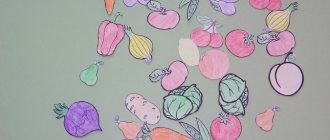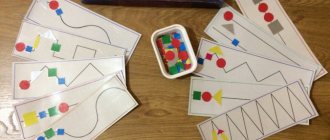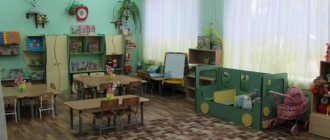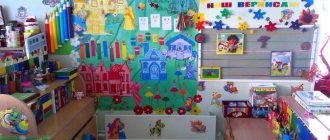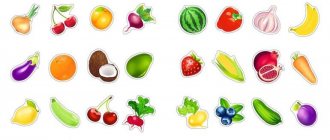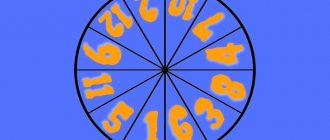"What changed?" — children's educational game with nesting dolls
The game develops the visual skills of preschool children. Trains a child, aged 3 - 4 years, to distinguish colors and sizes of objects, to remember the differences.
Type: Games with objects.
Didactic task: To train children in correctly naming objects and their actions (the nesting doll hid, ran, stood still), to notice and name the difference in the color of clothing and the size of the nesting dolls, to develop in children, aged 3 - 4 years, visual memory, voluntary memorization , observation, speech.
Game rule: Only the one who is named by the matryoshka - mother (the largest matryoshka) - answers.
Game action: Guessing what has changed in the arrangement of the nesting dolls.
Progress of the game: The teacher shows the children one by one five different-sized multi-colored nesting dolls. The children look at them. All nesting dolls are different in size and are dressed in different sundresses and scarves. Together with the children, the teacher names the colors of clothes and notes that all nesting dolls are different in size.
Children sit at a table in a semicircle; it is placed so that everyone can see the nesting dolls standing on the teacher’s table.
The teacher asks a question:
- Children, what do you see on my table? “Matryoshka dolls,” the children answer in unison. - Look at how tall the nesting dolls are. (Places two, then three, and then four nesting dolls next to each other.) Are they the same height or not? (“Different.”) What is different about them? Look carefully!
At first, the children find it difficult to answer correctly, the teacher helps them with leading questions:
- Look at the handkerchiefs. What are they? (Touches first one, then another nesting doll.) That's right. One nesting doll has a red scarf, another has a green one, and this one has a blue one. How can we say about handkerchiefs in one word? (“The nesting dolls have handkerchiefs of different colors.”) And sundresses? How can you say? Right. Their sundresses are also different. (Together with the children, name the color of each nesting doll’s sundress: red, green, blue.) Look at them and remember how the nesting dolls are dressed.
Now let’s play like this: I’ll cover the matryoshka dolls with a screen, and then you’ll find out which doll will hide. But you need to answer only one at a time, so the one who notices will come up to me and say quietly so that others do not hear. Next, the teacher draws the children’s attention to the size of the nesting dolls: he hides behind the screen first one, then another, then two at once.
When the game is played again, the one the matryoshka points to answers.
You can use other items in this educational game, depending on what problems are being solved.
Lesson notes for children 6-7 years old on memory development
Lesson on memory development in preschoolers 6-7 years old
Description of work: this program will be useful primarily for educational psychologists and kindergarten teachers when working with children starting from older preschool age (6-7 years). Classes are preceded by psychological diagnostics of visual and auditory memory. The goal of the program: to maximally promote the development of memory as a cognitive process in preschool children. Objectives: 1. development of voluntary memorization as the basis of the cognitive sphere in preschool children; 2. development of operational, short-term memory in a child; 3. development of indirect memorization in a child. The program is designed to ensure: 1. cognitive development of the child; 2. creating conditions for the development of the child’s personality and abilities; 3. optimal load on the child in order to protect him from overwork. Principles for constructing the program: 1. Accessibility of the proposed material, compliance with the age characteristics of children;
2. Systematicity and consistency in carrying out correctional work; 3. Personality-oriented approach to children. The program provides for the possibility of implementing an individual approach to the child, working with various subgroups of children, taking into account their age and psycho-physiological characteristics. Methodology:
Goal: to maximally promote the development of memory as a cognitive process in children. Objectives: 1. development of voluntary memorization as the basis of the cognitive sphere in preschoolers; 2. development of operational, short-term memory in a child; 3. development of indirect memorization in a child. The program is designed to ensure: 1. cognitive development of the child; 2. creating conditions for the development of the child’s personality and abilities; 3. optimal load on the child in order to protect him from overwork. Principles for constructing the program: 1. Accessibility of the proposed material, compliance with the age characteristics of children; 2. Systematicity and consistency in carrying out correctional work; 3. Personality-oriented approach to children. The program provides for the possibility of implementing an individual approach to the child, working with various subgroups of children, taking into account their age and psycho-physiological characteristics. Classes are held once every 2 days.
Thematic planning of correctional and developmental work with children:
Lesson 1.
Sedentary game “Camera” Purpose: development of visual memory skills The game is played with a group of children. One person is selected whose appearance the children must remember. Then he leaves the room and changes something in his appearance (an adult can help a child). After which he returns and the children must find the difference. Didactic game “Snowball” Purpose: development of auditory memory skills The first player names any word, the second repeats the named word and adds some of his own to it. The next one names the words named before him in order and adds his own word to them, etc. The one who makes a mistake is eliminated from the game. Outdoor game “Puppeteer” Purpose: development of motor memory. An adult “puppeteer” blindfolds the child and “leads” him like a doll along a simple route, holding him by the shoulders, in complete silence: 4-5 steps forward, stop, turn right, 2 steps back, turn left, 5-6 steps forward, etc. Then the child is untied and asked to independently find the starting point of the route and walk it from beginning to end, remembering his movements. The movements can be gradually made more difficult by increasing the duration of the route and including a number of simple physical exercises: tilt the “doll”, bend the arms, make him sit down, make a full turn over the left shoulder, etc. Didactic game “Do as I do” Goal: development of visual skills memory Children play in pairs. Initially, each child has 6 sticks. One, the leader, lays out a random composition from 6 sticks, then shows it to his partner for one or two seconds. The partner lays out exactly the same figure from his matches from memory. Then the children change roles. If successfully completed, the number of matches gradually increases to 12-15. Didactic game “Harvest” Goal: development of indirect memorization skills. Children are shown a set of paired pictures, mixed and laid out with the pattern down, forming a rectangle.
The players take turns opening and turning over two cards, calling out what is shown on them. If the pictures are different, then the cards are returned to their place. If there are paired cards with the image of the same object, the player takes them for himself. The children’s task: remember where the paired pictures are, try to find and open them. The one who collects the most paired cards wins. Lesson 2.
Sedentary game “Describe your neighbor” Goal: development of visual memory skills An adult and a child choose an object, person, familiar to both of them... whatever.
And you need to remember as many of its distinctive properties and signs as possible. You can name one attribute, one at a time. The loser is the one who cannot remember anything about this item when it is his turn. Didactic game "Button". Goal: development of visual memory skills Two people play. In front of them lie two identical sets of buttons (Diensha blocks), in each of which not a single button is repeated. Each player has a playing field - it is a square divided into cells. The player who starts the game places 3 buttons on his field, the second player must look and remember where each button is. After this, the first player covers his playing field with a piece of paper, and the second must repeat the same arrangement of buttons on his field. The more cells and buttons used in the game, the more difficult the game becomes. Didactic game “Artist” Goal: development of indirect memorization skills An adult tells the children: “Try to make a drawing for each of the words I named.” Fun party; Joy; Dark forest; Disease; Despair; Fast man; Courage; Sadness; Deaf old woman; Warm wind Didactic game “What has changed?” Goal: development of visual memory skills. Children are given 6-7 toys.
A signal is given for them to close their eyes, and at this time one toy is removed or their places are changed. Having opened their eyes, children must guess which toy is hidden. Didactic game "Find the differences." Goal: development of visual memory skills development of indirect memorization skills Children are shown two almost identical drawings and asked to find how one drawing differs from the other. Then one of the cards is removed. The child’s task: remember what was shown on the first card. Lesson 3.
Didactic game “Selection of paired pictures” Goal: development of indirect memorization skills Each participant receives 4 cards on which different objects are depicted. Children look carefully and then turn them over with the picture down. The presenter opens one of his cards. Children's task: remember and open a card with the same image. Sedentary game “Camera” Goal: development of visual memory skills The game is played with a group of children. One person is selected whose appearance the children must remember. Then he leaves the room and changes something in his appearance (an adult can help a child). After which he returns and the children must find the difference. Didactic game “Awareness of visual material.” Goal: development of visual memory skills For this exercise you will need a piece of paper, pencils and a stopwatch. The figure below contains 12 images. Children are invited to look at the drawings of the first line, covering the rest with a sheet of paper so that they do not distract attention. After 30 seconds, ask them to cover the entire page and draw the objects of the first line from memory. Then ask them to compare how their drawings
Didactic game Awakening the “sense of detail.” Goal: development of visual memory skills Move from concrete images to abstract ones. Offer the children four abstract figures to start with.
Children should look at each of them for a minute, while covering the others so as not to distract attention. Then ask the children to mentally imagine these figures in all details and draw each one on paper from memory. Didactic game “Do as I do” Purpose: development of indirect memorization skills Children play in pairs.
Initially, each child has 6 sticks. One, the leader, lays out a random composition from 6 sticks, then shows it to his partner for one or two seconds. The partner lays out exactly the same figure from his matches from memory. Then the children change roles. If successfully completed, the number of matches gradually increases to 12-15. Lesson 4.
Didactic game “Awareness of verbal material” Goal: development of indirect memorization skills The presenter says: “Now I will read (show) (depending on the type of memory being trained) words, after hearing (seeing) each word, imagine the appearance of this object , its taste, smell, sounds it can make, etc. For example, toothpaste looks white and shiny, has a minty smell and tastes sharp and sweet at the same time.”
As a preliminary training, you can invite children to first describe out loud the images evoked with the help of their senses, then move on to working “only in their minds.” Outdoor game “Puppeteer” Purpose: development of motor memory. An adult “puppeteer” blindfolds the child and “leads” him like a doll along a simple route, holding him by the shoulders, in complete silence: 4-5 steps forward, stop, turn right, 2 steps back, turn left, 5-6 steps forward, etc. Then the child is untied and asked to independently find the starting point of the route and walk it from beginning to end, remembering his movements. The movements can be gradually made more difficult by increasing the duration of the route and including a number of simple physical exercises: tilt the “doll”, bend the arms, make him sit down, make a full turn over the left shoulder, etc. Didactic game “Loto” Purpose: development of indirect memorization skills The child is invited remember the objects depicted in 3-4 pictures and name them from memory. Then he must find their image in 10-12 similar pictures, but randomly scattered. It can be used to recognize letters or numbers using specially made cards or a register of letters and numbers. Gradually, the number of memorized pictures can be increased. Didactic game “What has changed?” Goal: development of visual memory skills. Children are given 6-7 toys. A signal is given for them to close their eyes, and at this time one toy is removed or their places are changed. Having opened their eyes, children must guess which toy is hidden. Didactic game "Find the differences." Goal: development of visual memory skills Children are shown two almost identical drawings and asked to find how one drawing differs from the other.
Then one of the cards is removed. The child’s task: remember what was shown on the first card. Lesson 5.
Didactic game "Revival".
Goal: development of indirect memorization skills. The child is invited to become a wizard, capable of bringing to life anything with a magic wand. For example, he touches an object in his imagination and it comes to life, then the “wizard” tells everyone what he sees; after that the roles change. You can invite children to imagine some kind of beast, animal. After the image is created, ask them to “revive” the picture, i.e. so that the animal begins to move, to live its life in imagination. Children tell each other about their animals. Then the results are summed up, whose story turned out to be the most interesting. Didactic game “Chain of words”. Goal: development of visual memory skills 15-20 cards with images of individual objects are laid out in front of the child (for example, an apple, a trolleybus, a teapot, an airplane, a pen, a shirt, a car, a horse, a flag, a rooster, etc.). The child is told: “I’ll tell you a few words now. Look at these pictures, choose the one that will help you remember every word, and put it aside.” Then the first word is read. After the child puts the picture down, the second word is read, etc. Next, he must reproduce the words presented. To do this, he takes the pictures put aside one by one and, with their help, recalls the words that were named to him. An approximate set of words: fire, factory, cow, chair, water, father, jelly, sit, mistake, kindness, etc. Didactic game “Memorizing words”. Goal: development of auditory memory skills Ask children to remember several logically unrelated words. Start with 10 words, for example: tree table river basket comb soap hedgehog gum book sun These words need to be connected into a story: “Imagine a green beautiful TREE. A board begins to grow from it to the side, a leg comes down from the board, and you get a TABLE. We bring our gaze closer to the table and see a puddle on it, which flows down, turning into a whole RIVER. A funnel forms in the middle of the river, which turns into a BASKET. The basket flies out of the river onto the shore. You come up, break off one edge - you get a COMB. You take it and start combing your hair and then washing it with SOAP. The soap drips off, leaving hair sticking out like a HEDGEHOG. You feel very uncomfortable, so you take an ELASTIC BAND and pull your hair together with it. The rubber band can't stand it and bursts. When it falls down, it turns in a straight line and turns into a BOOK. You open a book, and from it the SUN shines brightly into your eyes.” First, children try to imagine a story written by an adult, then they practice themselves, making up a story (different words are used) and sharing it with each other. At the final stage, the adult dictates the words, and they, imagining themselves, remember them. Didactic game “Snowball” Purpose: development of indirect memorization skills The first player names any word, the second repeats the named word and adds some of his own to it.
The next one names the words named before him in order and adds his own word to them, etc. The one who makes a mistake is eliminated from the game. Lesson 6.
Didactic game “Artist” Goal: development of indirect memorization skills An adult tells the children: “Try to make a drawing for each of the words I named.” Wind Sadness Sunny day Illness Crying boy Brave act Rainy day Good swimmer Sick injection Beautiful hairstyle Didactic game “Button”. Goal: development of visual memory skills Two people play. In front of them lie two identical sets of buttons (Dyenesha blocks), in each of which not a single button is repeated. Each player has a playing field - it is a square divided into cells. The player who starts the game places 3 buttons on his field, the second player must look and remember where each button is. After this, the first player covers his playing field with a piece of paper, and the second must repeat the same arrangement of buttons on his field. The more cells and buttons used in the game, the more difficult the game becomes. Didactic game “Harvest” Goal: development of visual memory skills Children are shown a set of paired pictures, mixed and laid out with the pattern down, forming a rectangle. The players take turns opening and turning over two cards, calling out what is shown on them. If the pictures are different, then the cards are returned to their place. If there are paired cards with the image of the same object, the player takes them for himself. The children’s task: remember where the paired pictures are, try to find and open them. The one who collects the most paired cards wins. Sedentary game “Describe your neighbor” Goal: development of visual memory skills An adult and a child choose an object, person, familiar to both of them... whatever. And you need to remember as many of its distinctive properties and signs as possible. You can name one attribute, one at a time. The loser is the one who cannot remember anything about this item when it is his turn. Didactic game “Awareness of verbal material” Goal: development of visual (auditory) memory skills The presenter says: “Now I will read (show) (depending on the type of memory being trained) words, after hearing (seeing) each word, imagine the appearance of this object , its taste, smell, sounds it can make, etc. For example, toothpaste looks white and shiny, has a minty smell and tastes sharp and sweet at the same time.”
As a preliminary training, you can invite children to first describe out loud the images evoked with the help of their senses, then move on to working “only in their minds.”
We recommend watching:
Summary of a lesson on speech development in the preparatory group. Prepare a summary of a lesson on the development of lexical-semantic components of children's speech through speech therapy. Prepare a summary of an educational activity with health-saving technologies. Preparatory group Summary of GCD in the preparatory group. Krylov's fable “The Crow and the Fox”
Similar articles:
Ways to improve memory in older preschoolers
Games to develop memory for children 4-5 years old
Summary of a thematic music lesson for children 6-7 years old
Summary of GCD in the preparatory group on the topic: Kindergarten
Lesson notes for the preparatory group. Cultured man
Card index of didactic games on FEMP for children of the middle group
Card index of didactic games for FEMP
for the middle group
“Which is longer, wider?”
Target:
Mastering the ability to compare objects of contrasting sizes in length and width, to use in speech the concepts: “long”, “longer”, “wide”, “narrow”.
Content.
Noise outside the door. Animals appear: a baby elephant, a bunny, a bear, a monkey - friends of Winnie the Pooh. Animals argue about who has the longest tail. Winnie the Pooh invites children to help the animals. Children compare the length of the ears of a hare and a wolf, the tails of a fox and a bear, the length of the neck of a giraffe and a monkey. Each time, together with V., they define equality and inequality in length and width, using the appropriate terminology: long, longer, wide, narrow, etc.
"What changed?"
Target:
develop children's attention and memory.
Content
: Children form a circle. There are several children standing inside the circle. At a sign from the teacher, one leaves, then, upon entering, he must determine what changes have occurred inside the circle. In this version, the guessing child must count how many children stood in the circle at the beginning, how many remained, and, comparing these two numbers, determine how many children left the circle. Then, when repeating the game, the guesser must name the name of the child who left. And to do this, you need to remember the names of all the children standing in the circle and, looking at the rest, determine who is missing. A further complication could be this: the number of children in the circle remains the same (within five), but their composition changes. The guesser must say which of the children left and who took his place. This option requires more attention and observation from children.
“Which toy is hidden?”
Target:
Consolidation of ordinal counting.
Content:
Toys of different sizes and shapes are placed on the table in one line. Children look at the toys, count them, and remember them. One of the players leaves the room, and in his absence the children hide some toy. The child returning to the room must remember which number (and then size) of the toys was missing from the table.
“To whom how much?”
Target:
Understand the concept of “how much”
Content:
The presenter hands out cards with drawn boys and girls and their clothes, and puts a card with two girls on the table and asks: “How many hats do they need?” The children answer: “Two.” Then the child, who has a picture with two hats in his hands, puts it next to the card where two girls are drawn, etc. Children practice counting and counting by playing games with small toys. The game consists of the fact that the child, having received a card with drawn circles and counting them, counts out as many toys for himself as there are circles on the card. The cards are then mixed and dealt again. Children count the circles on their cards and, if there are more of them than the toys selected on the first card, they decide how many more toys need to be added or taken away if there are fewer circles. There should be a lot of toys on the table. And there are five circles on small cards (1, 2, 3, 4, 5). This number of circles in cards can be repeated several times. Children of middle preschool age are subject to higher demands in mastering spatial orientation.
“What is where?”
Target:
Practice determining the spatial arrangement of objects in relation to yourself “in front”, “behind”, “in front”, “left”, “right”, “above”, “below”.
Material:
Toys
Content
: The child stops in a certain place in the room and counts the objects in front, behind, left, right.
“When does this happen?”
Target:
Clarify and deepen children's knowledge about the seasons.
Content
: The teacher names the time of year (shows a picture) and the children answer what happens at this time of year and what people do.
"Yesterday Today Tomorrow"
Target:
Reinforce the concept of categories such as “yesterday”, “today”, “tomorrow”
Material:
Ball
Content:
The presenter throws the ball to everyone playing in turn and says: “We sculpted... when.” The catcher finishes the phrase, as if answering the question “when?”
We will go for a walk in the park….(today)
We visited grandma….(yesterday)
We will read a book...(tomorrow)
content .. 31 32 37 ..Lesson No. 27
Lesson in kindergarten. Didactic games “Guess who it is?”, “What has changed?”
Didactic exercise “Steamboat”
Goal: to teach children to distinguish and name goose, duck, chicken (toys and pictures); practice clear pronunciation of onomatopoeic words, the sound ы (isolated and in words); to develop spatial concepts, the ability to use adverbs and prepositions in speech.
Progress of the lesson
There is a bear cub on the teacher’s desk. He looks into the box and asks: “What’s in there?”
“Toys,” the teacher answers. “Now I will show them to the children, and they will name them.” He takes out chicken, goose, duck. Children name birds.
"Is this a duck?" - asks the little bear, pointing to the goose. “No, it’s a goose,” explains the teacher. “You see, he’s white, with a red beak, and he has a long neck.” So that you learn to distinguish birds, I will ask the children to name them again.” The teacher asks the kids not only to name the bird, but also to describe what it looks like. Gives a sample statement: “This, my dear, is a duck. Its beak is as thick as a shovel, its legs are short, and its paws are webbed. This is a chicken. Her beak is small, her legs are long and thin, she has claws on her paws,” etc. If the child answers correctly, the bird approves of his answer (the goose cackles, the duck quacks, the chicken clucks: “Whoa! Well done, baby!”).
Next, a didactic game “What has changed?” is carried out. There are 6-7 pictures on the flannelgraph depicting geese, ducks and chickens. At the teacher’s signal, the children close their eyes, then open them and say what has changed (no goose, no duck, no chicken and no goose). Next, the teacher changes the arrangement of the figures so that in their answers the children use adverbs and prepositions (“The birds stood in a circle, and in the center of the circle there is a large and important goose”; “There are geese at the top, chickens in the middle, ducks at the bottom”; “The birds follow each other.” friend: there are geese in front, ducks behind the geese, and chickens behind everyone. Left behind").
“Why are the chickens lagging behind? — the teacher reflects. “After all, the birds decided to go to the river to swim and dive.” — “Chickens will not go to the river, they don’t know how to swim,” the children answer, remembering V. Suteev’s fairy tale “The Chicken and the Duckling.”
The teacher removes the chickens. He says: “The geese and ducks came to the water, but they were afraid to go down. There is a large steamer on the water (shows). The steamer is standing, humming: s-s-s-s-s. How does it sound? “Y-y-y - smoke is coming from the chimney,” the steamer hums (children repeat the phrase 2-3 times; make sure they don’t forget to pronounce the sound y). “Smoke is coming from the chimney - s-s-s-s. I’m sailing away!” the ship shouted for the last time and sailed away. And the ducks and geese looked after him for a long time, talking to each other: “Ha-ha-ha, very big!” Quack-quack-quack, very beautiful!” Children reproduce “replicas” of geese and ducks, imitating the intonations of the teacher.
content .. 31 32 37 ..
